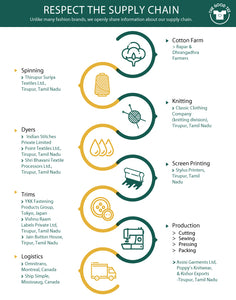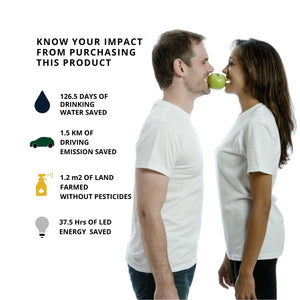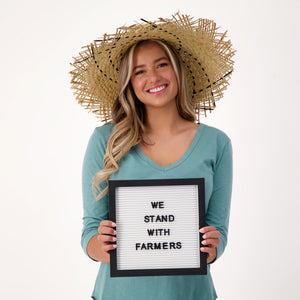#TheGoodTribe Meet the Queen of Capsule Wardrobes - Verena Erin Polowy, Founder & Editor of My Green Closet

Do you know that feeling, standing in front of a closet full of clothes and still not knowing what to wear? I sure do, and this feeling most often leads to mindless shopping and accumulation of clothes that are ‘disposable’ or meant to be worn for a short term only. In short, it’s the beginning of an unsustainable vicious cycle adding to the horrific carbon footprint of the fast fashion industry.
We at The Good Tee, believe in quality and continuously strive to enhance the lifespan of our clothes. Unlike fast fashion clothes which are designed for the wear-today/replace tomorrow lifespan. We are always looking to connect with good humans who, like us, believe that there is always an ethical and responsible alternative.
In our quest to expand our #goodtribe, we met Verena Erin Powly, the founder and editor of My Green Closet - a youtube channel, blog, and community for slow fashion, green beauty, and living more consciously. We had an insightful conversation with Verena where she talks about her passion and dedication to help people build a more conscious and minimal wardrobe, encouraging them to shop and live more consciously, and supporting designers and brands who are making sustainable changes in the industry. Here’s what she had to say.
1. Tell us about your journey from being a designer to a slow fashion influencer and how did My Green Closet start?
Through studying fashion design and working in the industry I became deeply passionate about sustainable and ethical fashion and doing my part to help change things for the better.
At the time I started the My Green Closet youtube channel no one was really talking about the environmental issues with fashion and with all the fast fashion hauls on youtube I felt it was a platform where these things needed to be brought up. I honestly never expected it to go anywhere, but it was nice to reach and connect with other people and spread awareness so I kept making videos and my audience kept slowly growing. I later added the blog and am pretty thrilled to now have something I’m so passionate about, be my job!

One of the biggest things I’ve learned is the power of “regular people” - both individuals and communities. It’s easy to think that you’re just one person and can’t do anything but your voice and actions can have a lot of power, especially as part of a larger movement.
I’ve been lucky to see the slow fashion movement grow immensely and incredible changes happen which are sparked by customers and citizens.

I start planning a capsule around the clothes I most love and enjoy wearing. I always tell people to look at the items that are constantly in your laundry basket and use that as a foundation to build your capsule around.
But more holistically I think it’s important to understand what you want from a capsule wardrobe - More time? Understand your personal style better? Save money? Invest in higher quality, slow fashion pieces? Reduce decision fatigue? Remove guilt from your closet? Or something else?
Capsule wardrobes can provide so many mental and lifestyle benefits so knowing what you want and how the capsule wardrobe concept can best serve you is the best place to start.

4. You are so passionate about Fashion Revolution, and apart from #WhoMadeMyClothes you also focus on #WhatsInMyClothes. Tell us more about it and why it is important to know the ingredients that go into our clothing.
The more I learned about the types of chemical processes, dyes, and treatments used in textile production the more shocked I became that as consumers we often have no access to any of this information - all we get to know is the fibre content but that is only part of what we’re wearing. We wear clothing on our skin every day which we know is our largest organ, so like lotions or creams shouldn’t we be able to know what we’re putting on our skin?
And on the manufacturing side, transparency is important to know what types of chemicals are being used in production AND how they’re being disposed of. As we know from documentaries like River Blue, fashion manufacturing can be horribly damaging to our water systems.

The idea of “perfection”. We want to do something “right” or 100% but with sustainability there is no perfect way to do something and 100% is often impossible. This can be challenging both personally as we tend to focus on what we’re doing “wrong” vs where we can make positive changes, and on a public platform as people like to pick apart and criticize everything.
For a while I felt a very high standard to live up to but now I see the value in sharing the less-than-perfect side of things, and discussing how we can all have different approaches and how we are also operating within a very broken system.
Trying your best and being open to learning and growing is what we should be focusing on, not perfection.

6. How can sustainable living be normalized in a world relying heavily on fast fashion? How do you involve more people in this conversation?
Well first I think we need to look at how fast fashion has made the world reliant on it and how that is a core part of the business model.
I don’t see fast fashion as just certain brands, I see it as a whole mindset we’ve been taught about fashion. I don’t think fast fashion is so much about what you buy but how you consume clothing. Fast fashion has created and fueled concepts like:
- Clothing being disposable
- You can’t wear the same outfit in photos
- Excessive consumption like hauls are glamourized
- Events require new clothes
- “Micro-trends” which constantly change
- And even that you can shop guilt-free and “sustainably” as long as you return your used clothes for recycling.


Fast fashion also works perfectly with our brains pleasure/pain response making it hard to resist.
So I think more so than saying, “don’t buy x brand, buy y brand” we need to have a conversation about breaking and challenging the things fast fashion has taught us and how to make our whole approach to clothing more sustainable which you can do no matter where you shop.
Things like:
- Purchasing items you know you’ll be able to wear a lot
- Mending and upcycling
- Normalizing and celebrating outfit-repeating
- Washing in cold water and air-drying
- Looking for natural or more sustainable fibres
- Caring for your clothes so they can last
- Understanding your personal style so you can avoid fleeting trends
- Being able to recognize signs of quality
- Demanding better practices from brands
- Ensuring old garments find a new home or are recycled
Are all examples of ways we can have a more sustainable wardrobe regardless of the brands in your closet.
Breaking this “fast fashion mindset” can be challenging though and it’s something I dig into further and help you personally analyze in my Quit Fast Fashion ebook.
7. What are your plans for My Green Closet in 2021 and beyond that you want us to know about?
I’ve got lots of interesting and exciting content planned and am thrilled to have added some other writers to the team this year to share their voices and perspectives on sustainable fashion and conscious living.
This year I also launched my sewing club! Sewing has been such a huge part of my life and it’s wonderful to not only share my experience and help others alter or make their own garments but it’s also been so fun having a community to hangout, chat, and sew together with.
Personally I’m very excited about my challenge to create an entirely locally sourced and made outfit and share the process of that.
In general though I’m just hoping to keep educating and inspiring people to think about where their clothes come from and how they can live a life that is fulfilling and still respectful to people and our planet.
Isn’t it phenomenal, what a woman with passion and creativity can do? Verena is the living example of the fact that we each have power to influence change and make the world a better place. She used her professional expertise in fashion to create a movement of sustainable lifestyle and strives everyday to reach out to more and more people to spread the love for our planet. It’s infectious, isn’t it?
Love the brand already? Share your thoughts, like, love, follow








Leave a comment